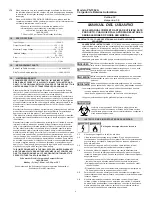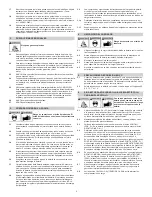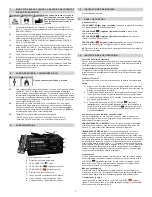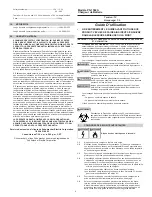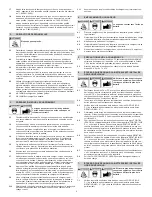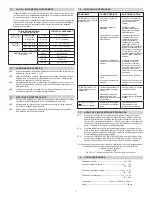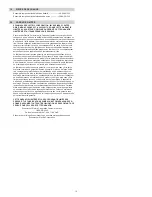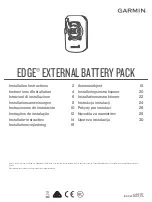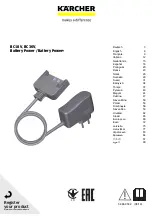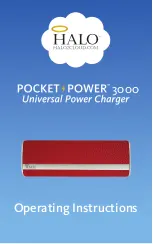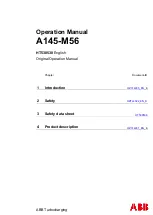
1
IMPORTANT: READ AND SAVE THIS SAFETY AND INSTRUCTION MANUAL.
SAVE THESE INSTRUCTIONS –
The PS-1562A offer a wide range of
features to accommodate your needs. This manual will show you how to use
your charger safely and effectively. Please read, understand and follow these
instructions and precautions carefully, as this manual contains important safety
and operating instructions. The safety messages used throughout this manual
contain a signal word, a message and an icon.
The signal word indicates the level of the hazard in a situation.
Indicates an imminently hazardous situation which, if not avoided,
will result in death or serious injury to the operator or bystanders.
Indicates a potentially hazardous situation which, if not avoided,
could result in death or serious injury to the operator or
bystanders.
Indicates a potentially hazardous situation which, if not avoided,
could result in moderate or minor injury to the operator or
bystanders.
Indicates a potentially hazardous situation which, if not avoided,
could result in damage to the equipment or vehicle or property
damage.
Safety messages in this manual contain two different type styles.
Unnumbered type states the hazard.
•
Numbered type states how to avoid the hazard.
•
The icon gives a graphical description of the potential hazard.
Pursuant to California Proposition 65, this product contains chemi-
cals known to the State of California to cause cancer and birth
defects or other reproductive harm.
IMPORTANT SAFETY INSTRUCTIONS
1.
Risk of electric shock or fire.
Do not expose the charger to rain or snow.
1.1
Use only recommended attachments. Use of an attachment not recom-
1.2
mended or sold by Schumacher® Electric Corporation may result in a risk of
fire, electric shock or injury to persons or damage to property.
To reduce the risk of damage to the electric plug or cord, pull by the plug
1.3
rather than the cord when disconnecting the charger.
An extension cord should not be used unless absolutely necessary. Use of
1.4
an improper extension cord could result in a risk of fire and electric shock. If
an extension cord must be used, make sure:
That the pins on the plug of the extension cord are the same size and
•
shape as those of the plug on the charger.
That the extension cord is properly wired and in good electrical
•
condition.
That the wire size is large enough for the AC ampere rating of the
•
charger as specified in Section 8.3.
To reduce the risk of electric shock, unplug the charger from the outlet
1.5
before attempting any maintenance or cleaning.
Remove personal metal items such as rings, bracelets, necklaces and
1.6
watches when working with a lead-acid battery. A lead-acid battery can pro-
duce a short-circuit current high enough to weld a ring or the like to metal,
causing a severe burn.
Do not operate the charger with a damaged cord or plug; take it to a quali-
1.7
fied service person. (Call customer service at: 1-800-621-5485.)
Do not operate the charger if it has received a sharp blow, been dropped or
1.8
otherwise damaged in any way; take it to a qualified service person. (Call
customer service at: 1-800-621-5485.)
Do not disassemble the charger; take it to a qualified service person when
1.9
service or repair is required. Incorrect reassembly may result in a risk of fire
or electric shock. (Call customer service at: 1-800-621-5485.)
PERSONAL PRECAUTIONS
2.
Risk of explosive gases.
Working in the vicinity of a lead-acid battery is dangerous. Batteries gener-
2.1
ate explosive gases during normal battery operation. For this reason, it is
of utmost importance that you follow the instructions each time you use the
charger.
To reduce the risk of a battery explosion, follow these instructions and those
2.2
published by the battery manufacturer and the manufacturer of any equip-
ment you intend to use in the vicinity of the battery. Review the cautionary
markings on these products and on the engine.
NEVER smoke or allow a spark or flame in the vicinity of a battery or engine.
2.3
Be extra cautious to reduce the risk of dropping a metal tool onto the bat-
2.4
tery. It might spark or short-circuit the battery or other electrical part that
may cause an explosion.
Use this charger for charging LEAD-ACID batteries only. It is not intended to
2.5
supply power to a low voltage electrical system other than in a starter-motor
application. Do not use this battery charger for charging dry-cell batteries
that are commonly used with home appliances. These batteries may burst
and cause injury to persons and damage to property.
NEVER charge a frozen battery.
2.6
NEVER overcharge a battery.
2.7
PREPARING TO CHARGE
3.
Risk of contact with battery acid. Battery acid is a
highly corrosive sulfuric acid.
Consider having someone close enough by to come to your aid when you
3.1
work near a lead-acid battery.
Have plenty of fresh water and soap nearby in case battery acid contacts
3.2
your skin, clothing or eyes.
Wear complete eye and body protection, including safety goggles and pro-
3.3
tective clothing. Avoid touching your eyes while working near the battery.
If battery acid contacts your skin or clothing, immediately wash the area with
3.4
soap and water. If acid enters your eye, immediately flood the eye with cold
running water for at least 10 minutes and get medical attention right away.
If it is necessary to remove the battery from the vehicle to charge it, always
3.5
remove the grounded terminal first. Make sure all of the accessories in the
vehicle are off to prevent arcing.
Be sure the area around the battery is well ventilated while the battery is
3.6
being charged.
Clean the battery terminals before charging the battery. During cleaning,
3.7
keep airborne corrosion from coming into contact with your eyes, nose and
mouth. Use baking soda and water to neutralize the battery acid and help
eliminate airborne corrosion. Do not touch your eyes, nose or mouth.
Add distilled water to each cell until the battery acid reaches the level speci-
3.8
fied by the battery manufacturer. Do not overfill. For a battery without remov
-
able cell caps, such as valve regulated lead acid batteries (VRLA), carefully
follow the manufacturer’s recharging instructions.
00-99-000979-0609
OWNER’S MANUAL
READ THE ENTIRE MANUAL BEFORE USING THIS
•
PRODUCT. FAILURE TO DO SO CAN RESULT IN
SERIOUS INJURY OR DEATH.
Model PS-1562A
Automatic Battery Charger
Voltage: 6, 12
Amperage: 1.5




